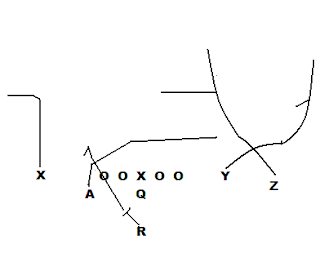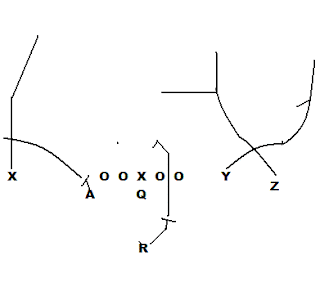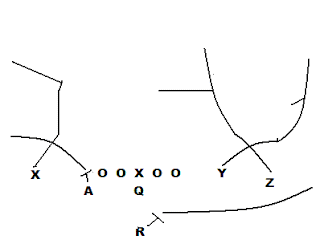
This ferment is ideal. A decade ago ideas were stagnant. Football was only for the purists, and if you failed to replicate the Platonic ideals, then you hadn't been schooled properly. Five years later, the beginnings of the ferment - turbulent, muddy, a vigorous undercurrent. Ten years later - today, now - the waters are flooding, spilling onto that once sacred ground.
Rich Rodriguez, the Johnny Appleseed of the Spread, has been hired by Michigan. The Pundits talk of the "the Spread," the "Gun Spread," the "Gun Option," the "Airraid," the "Zone Read," and the "Pistol." The coaches talk of these too, but they also talk of the "Gun Jets Sweep," and the "Gun Jets," the "Gun Veer," and the "Gun Triple."
The ideas stir. They stir football itself. This reexamination of all that came before - restless, relentless. The search for good ideas, new ideas, ideas never before dreamed of. This - the ferment - is not a fad. It cannot be. It is football itself: there's been a synthesis.
The 'Gun and its history.
The shotgun itself, the perceived center of all of this "newness," has its roots in the beginning of football, however.
Most commentators, of course, seem to deify the "shotgun" itself as an entire offense rather than what it is - a particular way to align your quarterback and perform the center-exchange. Ironically, however, they also take a restricted view of the gun’s presence in football history, presuming it was invented, alternative, in the 60s (Red Hickey), the 70s (Tom Landry), the 80s (pick somebody), the 90s (pick somebody), or the 2000s (whoever they root for, or often Urban Meyer or some passing coach). Regardless, it's somewhat silly.
The point of this article is to show that (a) the shotgun itself has ancient roots, and is not some passing fad, (b) and, thus by inference, the ferment and change I spoke of in the introductory paragraphs is not as limited as how you align your Quarterback.
Indeed, I imagine that the shotgun's history would surprise many such commentators. The “gun” was in many ways the standard back in the early days of football. Especially consider that the under-center snap was not invented until at least a decade or so after football itself was invented, if not longer. In fact, in the fairly early days, players had to actually short-kick the ball with their heel (don’t ask me!) back as a form of snap. Also, the gun and the pass have been around since 1908-1910 or so, since the forward pass was legalized and encouraged by rule changes due to the “brutal” nature of football at a time when the “single-wing” and almost all offenses involved shotgun type snaps which lead to melees resulting from attempts to advance the ball.
To demonstrate the trends, I think there are four good “watershed” type games that either were representative for the time or helped us get where we are today, though there are surely others.
1. Notre Dame vs. Army Part I
In 1913, Notre Dame traveled to West Point to face the heavily favored Army. Final score: 35-13, Notre Dame. Knute Rockne, the famous future coach but then little-known end, caught an array of passes from one Gus Dorais, who that day nearly revolutionized the position. The legend grows larger over time, and the forward pass had been legal for roughly eight years, but that day Dorais completed 14 of 17 passes for 243 yards and three touchdowns. Dorais even completed a pass to Rockne that, at the time, was the longest pass play ever. But more importantly, this game was the coming out party for the forward pass. Although this story might be collateral to the shotgun story – indeed Dorais was already operating out of the “gun” – but few would question that the forward pass still defines football today.
2. Notre Dame vs. Army Part II
By 1925, Rockne was Notre Dame’s coach. We all have heard these famous lines:
Outlined against a blue-gray October sky, the Four Horsemen rode again. In dramatic lore they are known as Famine, Pestilence, Destruction and Death. These are only aliases. Their real names are Stuhldreher, Miller, Crowley and Layden.
The four horsemen were four backfield mates who played for now-coach Knute Rockne. Most people forget the next few lines from that paragraph:
They formed the crest of the South Bend cyclone before which another fighting Army football team was swept over the precipice at the Polo Grounds yesterday afternoon as 55,000 spectators peered down on the bewildering panorama spread on the green plain below.
Notre Dame won 13-7. To our story, this game was not so much a watershed as it was representative of the time: Notre Dame ran an all-shotgun offense known as the “Notre Dame Box.” The “box” was a shotgun formation where the center could snap to any one of four guys, depending how they lined up. So, the most famous galloping backfield of all time played in the Gun, however bizarre it would appear by today’s standards.

This should serve as a firm rebuttal to the argument that the shotgun is currently new or (more popularly) was invented only to pass. This is flatly wrong. From the beginning of football, the shotgun was about running the football and faking. Indeed, it was even about power. Just ask the Four Horsemen.
3. Chicago Bears vs. Washington Redskins – The day the shotgun died.
In 1940 Bears Coach George Halas unleashed his under center offense on the Redskins on the way to a modest 73-0 victory. The Bears utilized the then-fairly rare “Tee Formation,” where the Quarterback (remember, he was originally so named because of how far back he aligned - the term was a rugby term before it was a football term) would in line up under center with three backs behind him in a straight “Tee.” Using this formation, along with a series of fakes, counters, traps, bootlegs, and other deception Halas’s Bears crushed the Redskins to win the NFL title. Note that the Redskins had beaten the Bears earlier that season.
For the next thirty to forty years, the unequivocal primary method for hiking the ball was the under center snap. This game is also important because it shows that faking, deception, and using multiple ball carriers is not new, nor is it exclusive to the shotgun. It is simply a distinct concept.
After this game the shotgun made a few appearances, most famously with Red Hickey with the 49ers and Tom Landry with the Cowboys. And in the 80s and later in the 90s teams as disparate as the Miami Dolphins with Marino, Purdue with Joe Tiller and Drew Brees, and the Hal Mumme Kentucky Wildcats (with the support of Mike Leach) set quite a number of passing records in the gun. But this modern revolution came about, I believe, because people had to see how you could throw and run from the shotgun.
Although Rich Rodriguez probably deserve smore credit than anyone for spreading the concepts themselves, it was Northwestern’s late-coach Randy Walker who I think turned the football coaching world on its head one blue-skied afternoon in November, 2000.
4. Northwestern vs. Michigan – The Modern Era Dawns.
Northwestern defeats Michigan 54-51. This is shocking enough. Northwestern scored fifty-four points against a Michigan team known for great defense and great defensive talent. Doubly shocking. Quarterback Zak Kustok threw for 322 yards and four touchdowns. Not so shocking from a spread QB in victory. Don’t they always have to throw for this much to win? That’s why they get in the gun, right?
But wait, there’s another stat.
Northwestern Rushing: 332 Yards; 6.64 average per carry. 332 yards.
What? Three-Hundred and Thirty Yards rushing?
How did they do that? Yes their running back had a huge day, but the yards that also made everyone sit up and take notice were the 55 yards from Northwestern’s quarterback, Zak Kustok – hardly Vince Young or Pat White in raw athleticism. But the light went off across the country. If Zak Kustok can do it, maybe my guy can too. And even if he’s not Vince Young, just the threat that he can make the defense pay if they over pursue by getting me eight yards, then let’s do it.
Obviously, not everyone running the spread now saw this game. Even Gun Guru Urban Meyer didn’t start running this offense until his Bowling Green days sometime after this game, and he admittedly went out to others to learn the offense. The shotgun run-game didn’t bubble up inside anyone like a well-spring. But this was the game that changed the landscape.
Where we are are now.
So Randy Walker and Rich Rodriguez blew the doors off. The gun is now fully part of the arsenal for nearly every team, and the sky is the limit on what you can do. The all-eleven offense, the pistol, and the single-wing itself are all part of the calculus. Who knows, maybe we’ll see a major team running the Notre Dame box.
I thought I’d provide a quick summary of some of the factors in the calculus for when you want to use the gun. Observe that many of the factors come from Coach Homer Smith, so I can’t too much credit.
Advantages of the Shotgun
- The QB can get deeper in a given amount of time (whether the 3 yard “pistol” snap or a 7-8 gun for passing)
- Lateral play faking (but not drop back style play action, at least so easily) can be achieved
- Relatedly, the zone-read is a kind of “bootleg-plus” in that instead of calling a blind bootleg, you make the backside defensive end wrong every time)
- Some QB's can see better (i.e. wider field of vision)
- The depth of the QB often forces the defense to expose its pressure plans more clearly
- The RB might be able to pick up a blitz better (i.e. no dropping QB to bump into)
- It does not need a snap count and helps mitigate crowd noise factors (though many still use a snap count)
Disadvantages of the Shotgun
- The QB has to take his eyes off the pass defense and has to watch the ball into his hands. This effect also somewhat reduces the QB’s ability to see the coverage and read changes (Cover 2 to 1, etc.) until after the snap. This is particularly acute for 3-step passes, where you have to catch and throw almost immediately. The read becomes almost exclusively pre-snap.
- The Shotgun alignment makes some lead-plays more difficult. I also would argue that the “gun-option,” as such, is not completely structurally sound in the way other veer plays are. Some gun teams have tried to develop the veer from the gun. Time will tell whether they are successful. (This requires more discussion than I have space for.)
- It becomes a crutch for the QB and an easy way to avoid improving footwork and play faking. I think this is an underrated problem. Footwork in the gun is (a) easier, because it is less, but is (b) prone to getting very, very sloppy. If there is any knock against “spread gun” QBs who go to the Pros, this one of the few viable ones, but can be simply overcome with good coaching.
- It retards the notion of a power run game and shifts more towards deception based delays, options, or draw type run plays. This is not a bad thing, though true.
- It can amplify your QB’s athletic skills, in either direction. If they are very athletic, it can improve their ability to make plays, but if they are not athletic many traditional QB plays – bootlegs, play action, and certain lead-option type run plays - are almost entirely out of the question.
- The footwork of the QB changes as does timing for pass plays. The "mesh" point for hand-offs to the RB change as well. Now Florida offensive coordinator Dan Mullen says this is one reason they run shotgun almost exclusively, so they can practice just one thing and get good at it.
So there are pros and cons. What this mostly counsels is a commitment to what you do, an organized, systematic approach to your offense, and an acknowledgment of where your weaknesses are as well as your strengths. The great shotgun teams work on this consistently, the haphazard teams will consistently both live and die by their sword-of-the-moment.








